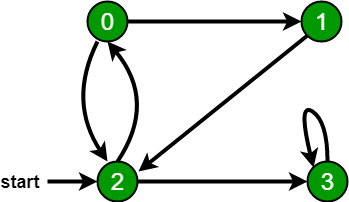Python Program for Breadth First Search or BFS for a Graph
Last Updated :
06 Mar, 2024
Breadth First Traversal (or Search)
for a graph is similar to Breadth First Traversal of a tree (See method 2 of
this post
).
The only catch here is, unlike trees, graphs may contain cycles, so we may come to the same node again. To avoid processing a node more than once, we use a boolean visited array. For simplicity, it is assumed that all vertices are reachable from the starting vertex. For example, in the following graph, we start traversal from vertex 2. When we come to vertex 0, we look for all adjacent vertices of it. 2 is also an adjacent vertex of 0. If we don’t mark visited vertices, then 2 will be processed again and it will become a non-terminating process. A Breadth First Traversal of the following graph is 2, 0, 3, 1.

Following are the implementations of simple Breadth First Traversal from a given source. The implementation uses
adjacency list representation
of graphs.
STL
\’s
list container
is used to store lists of adjacent nodes and queue of nodes needed for BFS traversal.
Python3
from collections import defaultdict
class Graph:
def __init__(self):
self.graph = defaultdict(list)
def addEdge(self, u, v):
self.graph[u].append(v)
def BFS(self, s):
visited = [False] * (max(self.graph) + 1)
queue = []
queue.append(s)
visited[s] = True
while queue:
s = queue.pop(0)
print(s, end=" ")
for i in self.graph[s]:
if visited[i] == False:
queue.append(i)
visited[i] = True
if __name__ == '__main__':
g = Graph()
g.addEdge(0, 1)
g.addEdge(0, 2)
g.addEdge(1, 2)
g.addEdge(2, 0)
g.addEdge(2, 3)
g.addEdge(3, 3)
print("Following is Breadth First Traversal"
" (starting from vertex 2)")
g.BFS(2)
|
Output
Following is Breadth First Traversal (starting from vertex 2)
2 0 3 1
Time Complexity
: O(V+E) where V is the number of vertices in graph and E is the number of edges
Auxiliary Space
: O(V) Please refer complete article on
Breadth First Search or BFS for a Graph
for more details!
Like Article
Suggest improvement
Share your thoughts in the comments
Please Login to comment...